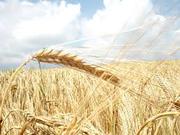Top-News
Share of corn in the general grain harvest to reach 44%
According to APK-Inform analysts, in Ukraine corn will restore its positions in the structure of general grain harvest in 2016. Corn production is expected to reach 25.6 mln tonnes, or 44% of the general grain harvest. At the same time, wheat production will reduce to 21.5 mln tonnes (to 37%), and barley production will total 8.6 mln tonnes (15%).
- Read more
- 2243 reads
Ukraine started planting corn for grain
As of April 7, agrarians of Ukraine started the planting campaign of corn for grain. To date, the planted areas reached 28.1 thsd ha in 13 oblasts. The planned areas under corn total nearly 4.5 mln ha, declared the Ministry of Agrarian Policy and Food of Ukraine.
- Read more
- 2342 reads
USDA data seen as neutral to bearish
The USDA released its Quarterly Grain Stocks and Prospective Plantings reports today causing a bearish reaction from the markets. Al Kluis of Kluis Commodities sees the report as price negative. "The USDA's corn acreage estimate is surprising to the high side. It will be interesting to see what today's trade does with the USDA's lower soybean estimate and lower wheat acreage estimate," Kluis says.
- Read more
- 2076 reads
In January, Ukraine increased the exports of corn and sunflower oil to the EU
In January 2016, Ukraine increased the exports of corn to the European Union by 84.8% compared with the index in the same month of 2015, declared the Ministry of Economic Development and Trade of Ukraine on March 26. According to the announcement, the exports of Ukrainian sunflower oil to the EU grew by 72.5%, rapeseed oil - up 6%, sugar - up 3.2%, eggs without shells - up 2.1%.
- Read more
- 2375 reads
Ukraine planted early spring grains throughout 583 thsd ha
As of March 18, 19 oblasts of Ukraine started the planting campaign of early spring grains. Agrarians planted grains throughout the areas of 583.2 thsd ha, or 23% of the plan, against 295 thsd ha, or 12% year ago, declared the Ministry of Agrarian Policy and Food of Ukraine.
- Read more
- 2076 reads
Agricultural commodities production decreased
In January-February 2016, the production volumes of agricultural commodities in Ukraine decreased by 2.1% compared with the same period in 2015 at the expense of fall of animal husbandry commodities, announced the State Statistics Service of Ukraine on March 14.
- Read more
- 2137 reads
Ukraine planted early spring grains throughout 217 thsd ha
As of March 11, fifteen oblasts of Ukraine started the planting campaign of early spring grains. Agrarians planted grains throughout the areas of 217 thsd ha, or 8% of the plan, declared the Ministry of Agrarian Policy and Food of Ukraine.
- Read more
- 2270 reads
Ukraine increase the spring crops planted areas by 1.7 mln ha
The planted areas under spring crops in Ukraine will increase by nearly 1.7 mln ha, which requires additional resources provision. Due to adverse weather conditions in the autumn, agrarians failed to plant winter grains throughout nearly 0.9 mln ha, and winter rapeseed throughout 237 thsd ha. In addition, the planted areas of almost 600 thsd ha did not receive sprouts at all, declared the First Deputy Minister of Agrarian Policy and Food of Ukraine, Yaroslav Krasnopolskiy on March 1.
- Read more
- 2037 reads
EU trade area promises new markets, but demands change
Ukraine’s hard-won Association Agreement with the European Union includes a free-trade deal that should open doors into markets long-closed to Ukrainian exporters. But to take advantage of the new opportunities, Ukraine’s exporters are going to have to make changes in marketing, business culture and production.
- Read more
- 2038 reads
Ukrainian wheat market - results of the first half of the season
Rather limited number of proposals of large-scale grain lots on the market, the unstable economic situation and devaluation of the national currency rates, became the key factors influencing on price formation in the market segment of wheat in the first half of 2015/16 MY. The current article focuses on some challenges faced by the market participants, price trends, and the prospects for further developments.
- Read more
- 2127 reads


















